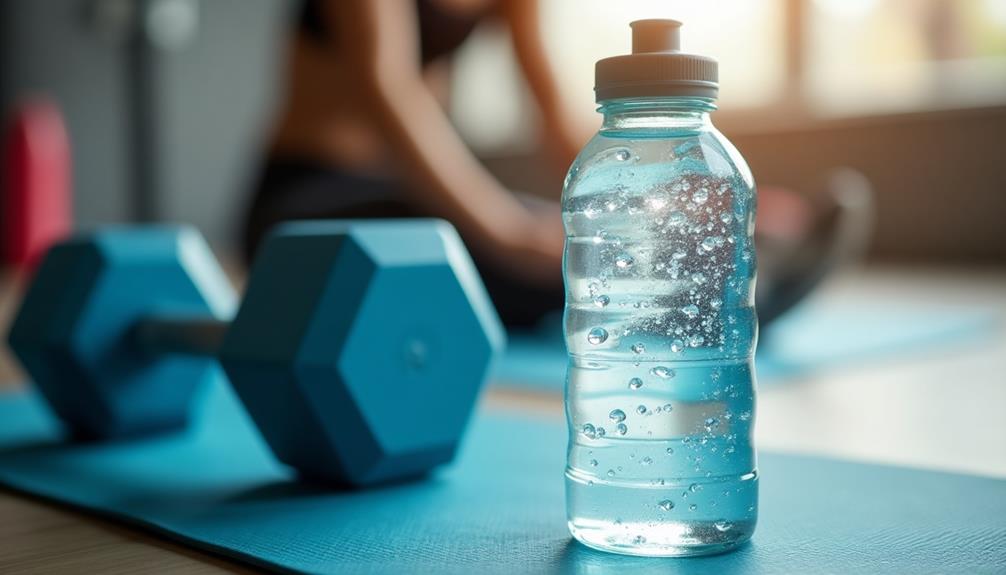To ensure effective muscle repair after lifting, focus on these five essential practices. First, prioritize proper nutrition by consuming a balanced diet rich in protein, carbohydrates, and healthy fats. Next, stay well-hydrated, as water helps transport nutrients to your muscles. Incorporate active recovery, like walking or gentle yoga, to enhance blood flow. Don't underestimate sleep—aim for 7 to 9 hours a night for best recovery. Finally, use stretching and foam rolling to relieve tight muscles and improve flexibility. Following these tips can greatly enhance your recovery, and there's plenty more to explore on improving your fitness journey.
Core Insights
- Prioritize a balanced diet with protein, carbohydrates, and healthy fats to support muscle repair and recovery post-lifting.
- Stay hydrated by drinking water and electrolyte-rich fluids like coconut water before, during, and after workouts.
- Incorporate active recovery through low-intensity exercises and gentle stretching to enhance blood flow and nutrient delivery to muscles.
- Aim for 7 to 9 hours of quality sleep each night to aid muscle repair and replenish energy stores effectively.
- Use dynamic stretching pre-workout and static stretching or foam rolling post-workout to improve flexibility and alleviate muscle tightness.
Prioritize Proper Nutrition

To effectively support muscle repair after lifting, prioritizing proper nutrition is essential. Your body needs the right nutrients to recover and rebuild stronger. Focus on consuming a balanced diet rich in protein, carbohydrates, and healthy fats. Protein plays a pivotal role in muscle repair, so include sources like chicken, fish, legumes, and dairy in your meals. Rapid-acting carbohydrates are particularly beneficial for rapid energy replenishment and best recovery post-workout. Consider incorporating carbohydrate powders that are easily digestible to support your nutritional needs.
Carbohydrates fuel your workouts and replenish glycogen stores, so choose whole grains, fruits, and vegetables. Healthy fats, found in nuts, seeds, and avocados, are important for hormone production and overall health. Don't forget to eat within a post-workout window, ideally within 30 minutes to two hours after lifting. This timing helps maximize recovery and sets you up for your next workout.
Stay Hydrated

Staying hydrated is important for muscle repair and overall recovery after lifting. Water plays a pivotal role in transporting nutrients to your muscles. When you lift, your body loses fluids through sweat, and replenishing these fluids helps avoid dehydration. Dehydration can impede your recovery, leading to muscle cramps, fatigue, and decreased performance. Coconut water is an excellent natural source of electrolytes and can be a great addition to your hydration routine. Many top coconut water brands offer products rich in potassium and other essential minerals that support muscle recovery.
To stay properly hydrated, aim to drink water before, during, and after your workouts. A good rule of thumb is to consume at least half your body weight in ounces daily. If you're exercising intensely, consider electrolyte-enhanced drinks for added benefits. Remember to listen to your body; if you feel thirsty, it's a sign you need to hydrate. Prioritizing hydration will support your muscle repair efforts effectively.
Incorporate Active Recovery

Incorporating active recovery into your routine can greatly enhance muscle repair after lifting. Active recovery involves low-intensity exercises that promote blood flow to your muscles without putting them under additional strain. Think of activities like walking, cycling, or gentle yoga. Post-workout carbohydrates can also play an important role in muscle recovery by replenishing glycogen stores and supporting protein synthesis.
These movements help flush out metabolic waste and deliver essential nutrients to your muscles, speeding up recovery. Aim for at least 20-30 minutes of active recovery on your rest days.
Additionally, listen to your body. If you're feeling particularly sore, opt for gentle stretching or light movements instead. By integrating active recovery, you not only support muscle repair but also maintain flexibility and reduce the risk of injury. It's a simple yet effective way to enhance your overall fitness journey.
Get Enough Sleep

Active recovery is just one piece of the puzzle when it comes to muscle repair after lifting. Getting enough sleep is essential for your body's recovery process. During sleep, your body works hard to repair muscle tissues and replenish energy stores. Aim for 7 to 9 hours of quality sleep each night. This not only helps with muscle growth but also improves your overall performance and reduces the risk of injury.
To enhance your sleep, establish a consistent bedtime routine. Create a comfortable sleep environment, free from distractions. Limit screen time before bed, as blue light can interfere with your sleep quality. By prioritizing rest, you'll feel more energized and ready for your next workout, ensuring your muscles recover effectively for best performance.
Use Stretching and Foam Rolling

Flexibility and mobility play important roles in muscle repair after lifting, and incorporating stretching and foam rolling into your routine can greatly enhance recovery. These practices help alleviate soreness and improve circulation, which is essential for muscle healing. Here are four key tips to get you started:
- Dynamic Stretching: Before your workout, engage in dynamic stretches to warm up your muscles and prepare them for lifting.
- Static Stretching: Post-workout, focus on static stretches to lengthen your muscles and improve flexibility.
- Foam Rolling: Use a foam roller to target tight areas, breaking down muscle knots and enhancing blood flow.
- Consistency: Make stretching and foam rolling a regular part of your routine for the best results.
Frequently Asked Questions
How Long Does Muscle Repair Typically Take After Lifting?
Muscle repair usually takes 24 to 72 hours after lifting, depending on the intensity of your workout and your individual recovery rate. Getting proper rest and nutrition during this time can speed up the process.
Can I Speed up Recovery With Supplements?
While supplements can support your recovery, they're not magic. Focusing on balanced nutrition, hydration, and rest often yields better results. You'll find that a holistic approach enhances your muscle repair more effectively than supplements alone.
Is It Safe to Lift Weights Every Day?
Lifting weights every day isn't usually safe for most people. Your muscles need time to recover and grow stronger. Consider alternating muscle groups or incorporating rest days to prevent injury and promote effective recovery.
What Signs Indicate Muscle Injury Versus Normal Soreness?
If you feel sharp pain while lifting, it's likely an injury. Normal soreness, on the other hand, usually fades within a few days. Trust your body—don't ignore persistent pain or swelling; seek advice if needed.
How Does Stress Affect Muscle Recovery?
Stress can hinder your muscle recovery by increasing cortisol levels, which may lead to inflammation and slow healing. Reducing stress through relaxation techniques helps your body repair and rebuild stronger after workouts.

